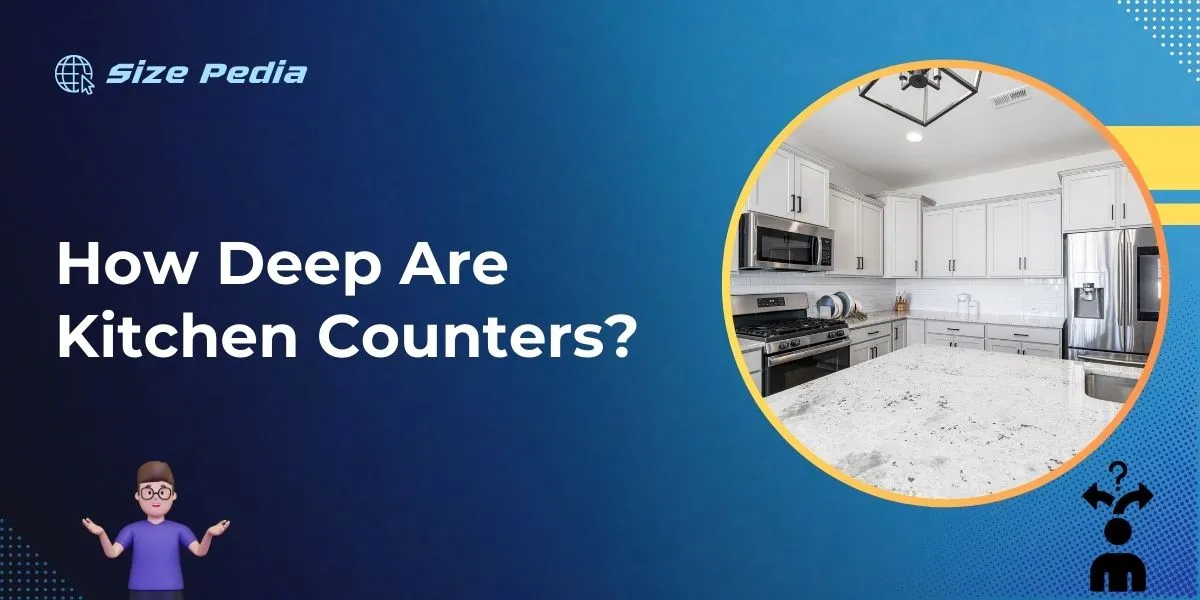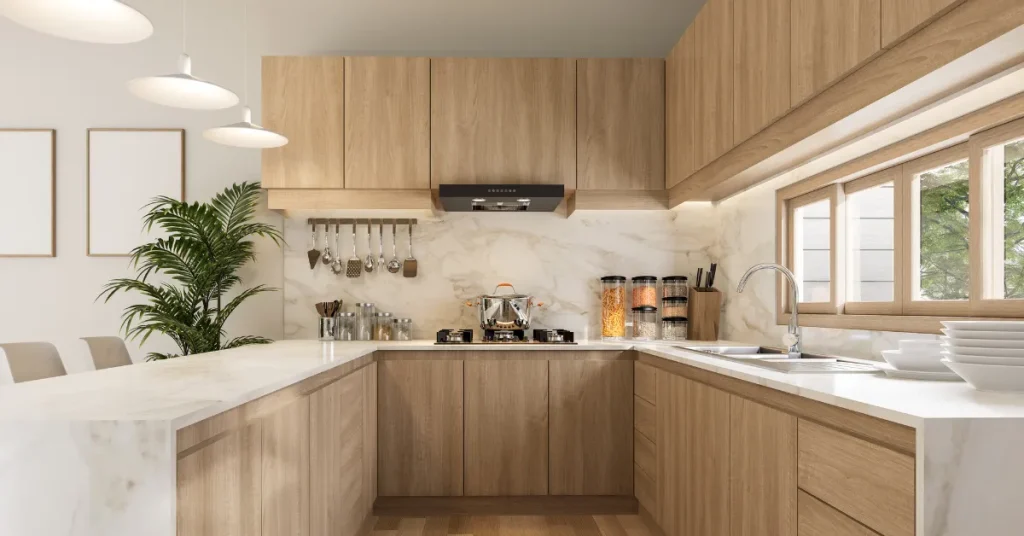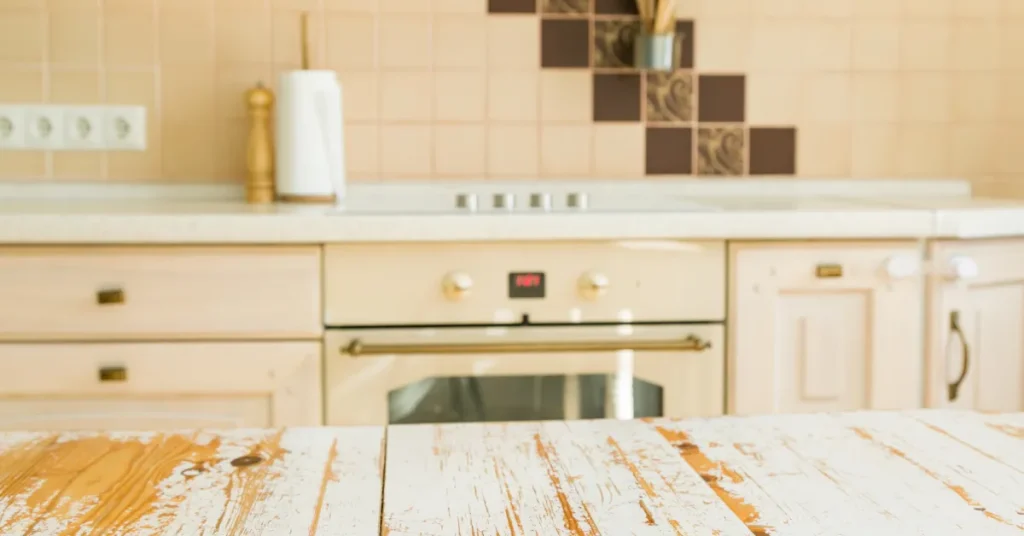Standard kitchen counters have a depth of 24 to 25 inches. This measurement excludes the backsplash.
Kitchen countertops are a critical component in any kitchen design, serving as both a functional workspace and a significant influence on the room’s aesthetic.
The standard depth of 24 to 25 inches for countertops has been established to offer ample space for food preparation and accommodate common kitchen appliances.
This depth also ensures comfortable reach and usability for most users. Striking the right balance between design and functionality is crucial, and the industry-standard counter depth plays a significant role in achieving that objective.
With kitchen ergonomics in mind, these dimensions cater to efficient movement and tasks within the kitchen, while also aligning with standard cabinet sizes for a seamless installation.

Why Counter Depth Matters
Kitchen counter depth plays a crucial role in both design and functionality of a kitchen space. The right depth ensures a balanced look and provides comfort during use. Finding the optimal counter depth can transform the kitchen experience.
Impact On Kitchen Aesthetics
A kitchen’s beauty often lies in its symmetry and clean lines. Counter depth directly influences this aesthetic appeal. It shapes how appliances integrate with cabinetry and how the workspace looks and feels.
- Flush countertops with kitchen appliances create a sleek, modern look.
- Varying depths can add dimension and interest to the kitchen layout.
- Proper depth selection prevents a cramped or cluttered appearance.
Functional Design And User Comfort
The depth of kitchen counters is key to a user-friendly kitchen. Deeper counters offer more work surface and storage while shallower ones can save space in a small kitchen.
| Depth | Advantages | Considerations |
| Standard (24-25 inches) | Ample workspaceWide range of appliance options | Universal design accommodates most users |
| Narrow (<24 inches) | Saves space in smaller kitchensReduces reach for overhead cabinets | Limited workspace can restrict cooking tasks |
| Deep (>25 inches) | Extra space for appliances on the counterIncrease in available storage underneath | Potential for difficult reach and wasted space |
Custom depths can maximize comfort and efficiency for individual cooking styles and physical needs. Important tools stay within easy reach, reducing strain and increasing safety.
The Standard Depth Of Kitchen Counters
Ever wondered about the perfect size for a kitchen counter? The standard depth matters. It shapes kitchen design and affects usability. Most kitchen counters share common dimensions. The standard depth is typically 24 to 25 inches.
Comparing Regional Variations
Kitchen counters vary across regions. This variation caters to different styles and ergonomic standards. In Europe, for example, counters often run deeper than in the USA. Below is a comparison of regional counter depths:
| Region | Standard Depth |
| USA | 24-25 inches |
| Europe | 25-26 inches |
| Australia | 23.5-24.5 inches |
Influence Of Appliances On Depth
Appliances shape counter depth. Built-in ovens and dishwashers need particular space. Designers often adjust counter depth for such appliances. This ensures a flush fit and a seamless look. Here are common adjustments:
- Refrigerator panels add 1-2 inches
- Dishwasher accommodation may increase depth
- Range design can influence counter frontage
Each appliance plays a role in determining the final counter depth. Selecting appliances before finalizing counter depth is crucial for a uniform kitchen design.
Customizing Your Kitchen’s Counter Depth

Kitchen counters serve as the workbench for your culinary creations. Standard counter depth is usually 24 to 25 inches, but not every kitchen is one-size-fits-all.
Tailoring counter depth can enhance your kitchen’s functionality and style. Finding the right depth means considering how you use your kitchen.
Personal Cooking Habits And Space Use
Think about your cooking style. Do you spread out ingredients, needing more counter space? Or, do you work with a compact setup?
- Large spreads might need deeper counters.
- Compact cooks can opt for standard depths.
Assess your kitchen gadgets. Large appliances need more room. The counter should accommodate them without feeling cramped.
| Appliance | Recommended Counter Depth |
| Coffee Machine | 24 inches |
| Stand Mixer | 30 inches |
Space for prep also impacts counter depth. Will you chop, marinate, and assemble dishes in this area? Extra depth could be a game-changer for meal prep.
Incorporating Seating At Counter Spaces
Dining at your counter? Comfortable overhang is key. Different seating options require various overhang depths.
- Bar stools need more overhang.
- Bench seating requires less.
Consider this: counters doubling as eating areas need an overhang of at least 15 inches. It ensures enough legroom for seating without knees hitting cabinets.
- Family-friendly: Deeper counters create communal space.
- Solo eaters: A smaller overhang suffices.
Think of the number of seats. More seats equal more length needed for comfort. Ensure everyone fits without squeezing together.
Remember, counter depth in your kitchen should mirror your lifestyle. Don’t be afraid to go beyond the standard if it means better functionality and enjoyment of your cooking space.
Materials And Their Role In Depth And Durability
The material chosen for kitchen countertops not only impacts the visual appeal and functionality but also determines the depth and durability of the surface.
A countertop’s depth is critical for both the aesthetic proportions of a kitchen and practical utility, while durability ensures it can withstand daily wear and tear.
Pros And Cons Of Common Countertop Materials
Different materials come with their unique benefits and drawbacks:
- Granite: Adds luxury, very durable but requires regular sealing.
- Quartz: Low maintenance, not tolerant of high heat.
- Laminate: Economical, less resistant to scratches and heat.
- Marble: Exquisite, prone to staining without proper care.
- Concrete: Customizable, needs sealing to prevent stains.
- Butcher Block: Warm look, requires regular oiling.
- Stainless Steel: Modern, may dent or scratch over time.
Material Thickness And Its Effect On Counter Depth
The thickness of countertop material can dramatically affect overall counter depth and its durability.
| Material | Standard Thickness (in inches) | Depth Impact |
| Granite | 1.25″ | Better resistance to weight and wear |
| Quartz | 0.75″ – 1.25″ | Varied durability depending on brand |
| Laminate | 0.5″ | Ideal for lightweight use, less durable |
| Marble | 0.75″ – 1.25″ | Thicker cuts boast better longevity |
Expert Tips For Maximizing Kitchen Counter Space
Kitchens are busy places and every inch of counter space counts. Counter depth plays a big role. But there’s more to maximizing this space than dimensions. Begin with smart strategies and the right fixtures to make the most of your kitchen counters.
Smart Storage Solutions
Keep counters clear and functional with clever storage ideas. Think vertical with hanging racks for utensils and spices.
- Use wall space for shelves and hooks.
- Drawer dividers create extra room for tools and cutlery.
- Pull-out pantry units store goods out of sight.
Make a note of innovative corner solutions like lazy Susans. Magnetic strips keep knives off the counter but within reach.
Selecting The Right Sink And Appliances
Choosing the right features can free up space. A deep single bowl sink tucks dishes away neatly.
- Opt for compact appliances that fit your lifestyle.
- Consider multi-functional devices to reduce clutter.
- Integrated appliances blend in, providing a smooth surface.
Avoid the trap of oversized fixtures. Match sink and appliances to the kitchen’s scale for a balanced look and better flow.
Renovation Process Of Kitchen Counters

Embarking on a kitchen remodel asks for meticulous planning and design decisions. The depth of kitchen counters plays a crucial role in both aesthetics and functionality. Understanding standard dimensions ensures a seamless renovation journey.
Working With A Kitchen Designer
Forging a partnership with a kitchen designer can transform your vision into reality. A designer works within the realms of space and ergonomics to create a cohesive kitchen plan.
They factor in the precise dimensions, including counter depth, to optimize workflow and storage. Outline your needs and engage with a professional to bring expertise to your countertop choices.
Considering Resale Value With Counter Choices
Selecting countertop options is not just about personal style; it’s also about smart investment. Quality materials and practical dimensions, like counter depth, can significantly affect your home’s resale value.
Prioritize choices that appeal to a broad audience, ensuring they are both stylish and functional. Assess materials and thickness that stand the test of time and usage, contributing to overall resale allure.
Kitchen Counter Depth Insights
| Standard Depth | Dimensions (inches) |
| Base Cabinets | 24-25 |
| Upper Cabinets | 12-13 |
| Islands | Varies based on design |
Begin with standard measurements and tailor to your needs. Discuss options with your kitchen designer to find a balance between standard sizes and customized solutions. Remember, custom depths can create unique challenges in the renovation process.
FAQs About How Deep Are Kitchen Counters
What Is The Standard Depth Of Kitchen Counters?
The standard depth of kitchen counters typically measures 24 to 25 inches from the wall to the edge. This size accommodates most appliances and provides ample workspace.
Can Kitchen Counter Depths Be Customized?
Yes, kitchen counter depths can be customized to suit individual needs and kitchen layouts. Custom depths can range beyond the standard, allowing for more surface area or fitting into unique spaces.
Do Counter Depths Include The Backsplash?
Standard counter depth measurements do not include the backsplash. Backsplashes typically add an extra half-inch to an inch but vary in thickness depending on material and design.
How Do Counter Depths Affect Kitchen Ergonomics?
Proper counter depth enhances kitchen ergonomics by making it easier to reach and use the entire surface without overstretching. Custom depths should consider the user’s height and the tasks performed.
Conclusion
As we’ve explored, standard kitchen counter depth brings both aesthetic harmony and practical utility to your culinary space.
Tailoring dimensions to personal preference and ergonomic comfort can enhance your cooking experience. Remember to consult with design professionals for custom solutions.
Choose wisely to make your kitchen both functional and inviting for years to come.
Resources:
1. https://www.usda.gov/media/press-releases/2023/11/13/keep-risky-habits-out-kitchen-thanksgiving
